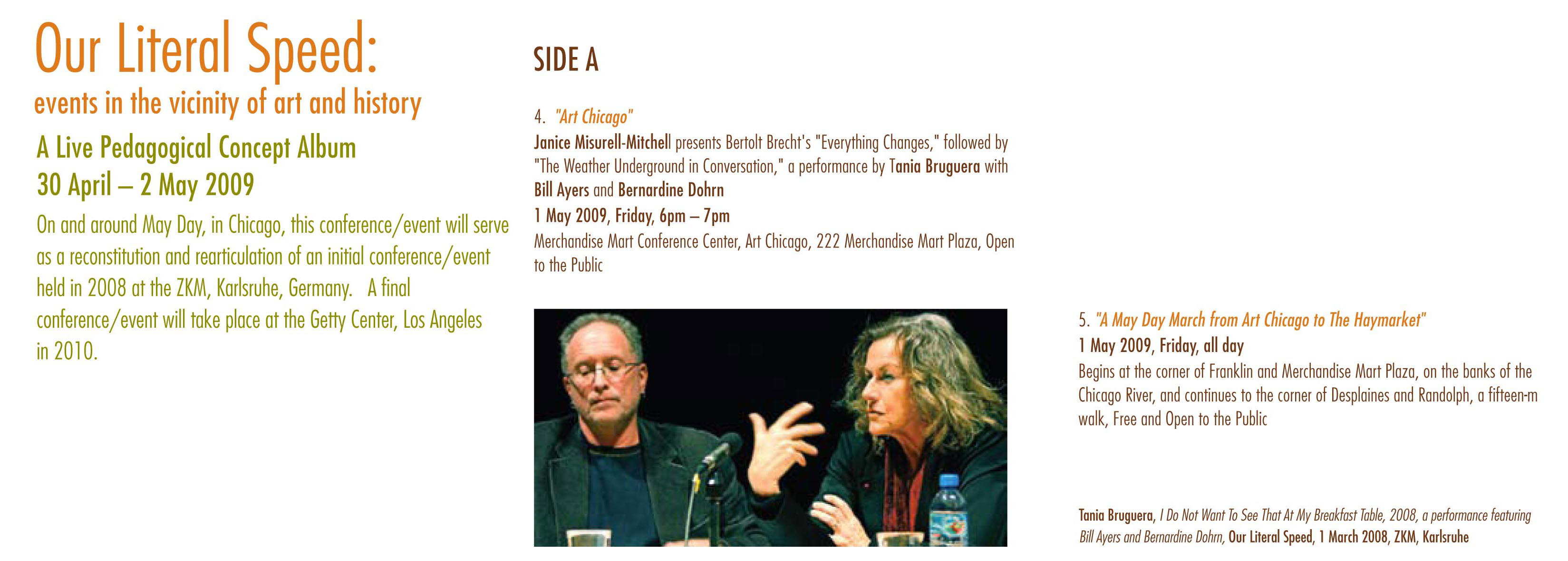(Je-jitz): Interactions with art
Erin Dziedzic
08.05.2009
From: Dziedzic, Erin: “Tania bruguera, The Weather Underground in Conversation,” For -The Weather Underground in Conversation-, presented in coordination with Our Literal Speed. Interaction with art blog. May 8, 2009. Chicago, United States.
http://erindziedzic.blogspot.com/search?q=Bruguera
Tania Bruguera, The Weather Underground in Conversation
Art Chicago Speaks
May 1
Erin Dziedzic
Everything Changes a flute/voice and percussion performance by Janice Misurell-Mitchell and Dane Maxim Richeson set the tone for the discussion to follow by giving an echo to the idea of change and prompting us to listen to the conflicting notions that change is possible and in the same breath is impossible. Performing the poem, Everything Changes by Bertolt Brecht, MisurellMichell (flute/voice) stutters into her flute the audible words like change and breath, overemphasizing repetition and the possibility for change derived from perseverance. On percussion, Richeson keeps to steady vignettes from marches to suggest “no change.” This spoken word/musical performance, while a bit funny at times as Misurell-Mitchell’s face took on some very tense and teeth bearing moments as she put strength to the word change, made a great segue into a politically charged panel discussion led by educator/activists William Ayers and Bernardine Dohrn.
Tania Bruguera’s presence in this panel discussion was short. She introduced the panelists and excused herself from the table in order to participate as a audience member. Before she left the table she presented us with a question that she had only made privy to the panelists ten minutes prior. If you could create a new law what would it be?
William Ayers jumped right in by answering, a law where U.S. citizens living in any country could vote in a Presidential Election. This could certainly bring about a wave of change. He then offered up a well paced account of how the idea of change has been such a sustaining factor in his life. It is something which has caused frustration at times, overwhelming happiness and most importantly, more change. It is this ever present thing that we can recognize as either a positive or negative thing depending on ones own personal convictions. For instance, as Bernardine Dorhn jumped into the conversation and began by asking everyone if they had participated in the May Day march earlier in the day, a young audience member decided that he had heard enough of what I can only image he thought of as petty attempts to make change. Shouting at the panelists, he insisted that these “movements” or public gestures toward change were in fact not making much of an impact because there were still so many union workers still suffering to make end meat in this country. While he mentioned that he thought that the movements and demonstrations of the past were much more emotionally and physically significant, the peaceful march of solidarity proved to not be enough for the young man. This prompted another audience member to fire off frustrations as well at his thoughts of an apparent lack of platforms for “real” change. Dorhn offered the suggestion that having ones glass half empty was probably not a good start. So finally after the ranting and raving the question came to be. What can I do to make any kind of change?
It’s the perfect question. It took a bit of unnecessary shouting and pessimistic attitude to reach it. But there it was, staring all of us in the face who have wanted to make change in some way but were either too lazy, preoccupied, or unsure about our own convictions. Dorhn was smart and never did answer the question explicitly because there is not one answer. Change comes from within and is derived from a myriad of personal, socio-political, and experiential factors that align in many different ways for every person and makes up ones own drive for change. Similarly, as she stated, ” the American flag means different things to different people,” so does the idea behind and motivation for change. Several other audience members brought up their own thoughts and ideas about change from the seemingly smaller things we can do such as keeping the lines of communication open to finding ones own drive for change within their practicing art form.
The original question that Ms. Bruguera presented at the beginning of the panel (If you could create a new law what would it be?) functioned in such a unique way as to end the event with such an important question for artists in these economic times (What can I do to make change?). After all, it was less about making a law, that idea of “no change,” and more of a discussion about evolving with change which embraces the fluid nature of change and how artists are a fundamental part in this strengthening momentum.
